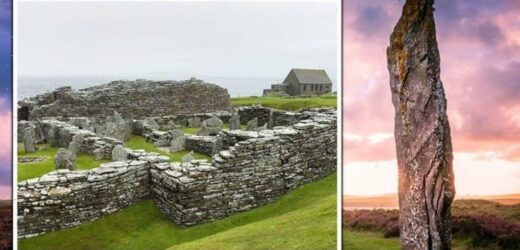Heatwave exposes neolithic henge at Brú na Bóinne Ireland
We use your sign-up to provide content in ways you’ve consented to and to improve our understanding of you. This may include adverts from us and 3rd parties based on our understanding. You can unsubscribe at any time. More info
Orkney is the heart of the Neolithic North. A mysterious archipelago made up of over 70 islands, it is almost 880 miles from Land’s End in the southwest of England — Britain’s most south westerly point. It has become a magnet for archaeologists, historians and other researchers for years, and for good reason.
Six thousand years ago, ancient humans — people of the Neolithic Age, the ‘New Stone Age’ — settled in Orkney.
They became Britain’s first farmers, toiling the land and erecting permanent homes for themselves, many of which remain today.
The remnants of their vibrant culture were explored during the Smithsonian Channel’s documentary, ‘Aerial Britain: Scotland’.
Here, the documentary’s narrator noted: “Here are islands that hold many secrets, secrets which are slowly being unearthed and rewriting history books.”


Skara Brae, one of the settlements, has attracted particular attention from researchers.
Located on the Mainland’s west coast, it is Orkney’s most visited ancient site and regarded by many as one of the most remarkable prehistoric monuments in Europe.
Myriad relics have turned up at Skara Brae, with the documentary’s narrator noting: “It is a 5,000-year-old settlement that has been called the Scottish Pompeii.”
It was only discovered in 1850 after a storm stripped earth from the site and revealed the stone structures.
Since, it has offered an unparalleled window into the lives of those who once lived there.
Each house shares the same basic design: a single large room fitted with stone-built cupboards, dressers and beds, all laid out around a square hearth.
JUST IN: Scientists warn ‘toxic’ WW2 shipwreck risks ecological disaster

Here, the inhabitants would have gathered around the fire to keep warm in the harsh Orkney winters.
Another Mainland settlement, the Broch of Gurness, dates from a later period and was built in around 500 BC.
At the centre of this settlement stands a brooch or a tall stone tower.
Researchers think it would have originally only reached a height of around 30 feet.
They believe it was most likely inhabited by the principal family or clan of the region, and may have been home to as many as 40 families.
DON’T MISS
Earthquake warning: Simulation showed magnitude 20 quake ‘could occur’ [REPORT]
Galileo blow as BT signs historic deal with UK alternative [INSIGHT]
Alien life: Huge boost to Oumuamua ‘artificial origin’ theory [ANALYSIS ]


Excavations are ongoing at many of the sites across Orkney.
At the end of October, archaeologists found what they believe to be fingerprints on fragments of clay, left behind by a young apprentice 5,000 years ago.
Experts went on to attribute the prints to a 13-year-old boy.
Finger marks left by a young male, possibly the same boy, and two adult men were previously discovered on fragments of pottery at Orkney’s Ness of Brodgar.

Archaeologists suggest the prints were left as experienced potters showed newcomers how to shape a piece of clay.
The University of the Highlands and Islands Archaeology Institute — which leads the excavations — said the latest prints were found by ceramics specialists Roy Towers and Jan Blatchford.

The two were examining a collection of sherds — fragments — at the Heart of Neolithic Orkney World Heritage Site.
The institute explained that it was able to determine the sex and age of a person from their fingerprint via many indicators: for example, the distance between ridges increased as an individual grew, and male ridges were usually broader and so easier to spot.
Source: Read Full Article


